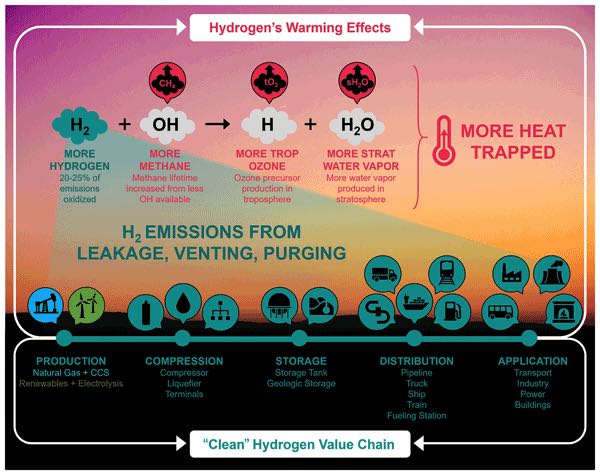Hydrogen has emerged as the great white (or green) hope of the clean energy transition due to its potential use in decarbonising hard-to-abate industries like shipping, steel production, and even transport.
These sectors are tricky to electrify. Cargo ships for example, can’t necessarily recharge battery supply in the middle of the ocean, and cutting emissions from steelmaking is a mammoth task.
But despite the potential utility of green hydrogen fuel across these industries, there are still many unknowns about what it means to integrate the technology into global industrial processes, or the effects this will have on the climate.
A new study from the US-based Environmental Defense Fund has found that the climate impacts from hydrogen technology – even in it’s greenest form – could be worse than anticipated.
The research shows that emissions associated with hydrogen leakage – including from renewables-backed hydrogen – have been substantially underestimated.
The authors say that it is unclear how effective hydrogen will be as a decarbonisation strategy, due mainly to complexities with measuring actual leakage rates, and the warming effects of the gas itself.
Is hydrogen carbon neutral?
Hydrogen is widely touted as a zero-emissions fuel. This is true, in some respects. The burning of hydrogen to power industrial processes does not produce significant levels of greenhouse gasses, such as carbon dioxide.
The actual production of hydrogen, however, can be achieved with the support of renewables, natural gas, and other fossil fuels, all of which vary in their emissions output.
But there is another dimension to hydrogen’s climate impacts, which scientists from the EDF say has been largely overlooked: the release of hydrogen molecules into the atmosphere.
The authors show there is significant potential for hydrogen to cause indirect warming impacts through the leaking of hydrogen molecules during the lifespan of the fuel, including through (incidental) leakage, or deliberate venting and purging.
This is because when hydrogen is released into the atmosphere, it increases the concentration of existing greenhouse gasses such as methane, or even water vapour, propelling climate-warming processes.
Hydrogen molecules are so small that this leakage can occur at any point along the hydrogen value chain, such as during production, storage, or even when transported through a pipeline, the study says.
Scientists have long understood that hydrogen can cause indirect warming effects, but the EDF notes that growing interest in the fuel as a tool for decarbonisation across several industries is likely to multiply the opportunities for leakage and climate damage.
“Projections suggest that demand [for hydrogen] could increase up to 10-fold by mid-century with applications ranging from industrial processes, building heating, and a diversity of transportation systems.”
And how much damage is done will depend on exactly how much hydrogen is released in the coming decades, and whether or not we have the tools to measure it.
Measuring hydrogen emissions
While greenhouse gasses such as carbon dioxide linger in the atmosphere for hundreds of years, hydrogen lasts only a couple of decades, and despite its relatively short lifespan, hydrogen is incredibly potent.
Normal measures which analyse the impacts of gasses in the atmosphere (such as CO2) usually focus on their long term impacts, across one hundred years or so.
Bur EDF scientists say that this long term view conceals the actual impact of hydrogen molecule leakage, which has remarkably strong effects during the decades it is present in the atmosphere.
These conventional metrics mask the “true impact of hydrogen during the decades in which it is influencing the climate, providing the inaccurate perception that hydrogen’s warming effects are much smaller than they are.”
On top of all this, the study says there is no way to tell how much hydrogen is currently leaked into the atmosphere. Current data on leakage rates across the hydrogen production and distribution process are all but non-existent:
“The total amount of emissions (e.g. leakage, venting, and purging) in current hydrogen systems remains unknown as empirical data on leakage rates from specific infrastructure (such as electrolyzers, pipelines, vehicles, and storage) are completely lacking.”
And the commercial technology required to record and measure such information is similarly scarce.
While these issues are present across all forms of (so-called) clean hydrogen, they are especially significant for ‘blue’ methane-based hydrogen, which must consider the emissions associated with the fuel’s production as well as leaked hydrogen molecules.
“Blue hydrogen is subject to additional impacts on the energy balance due to residual emissions of CO2 as well as emissions of methane from the natural gas supply value chain.”
“While more work is needed to evaluate the warming impact of hydrogen emissions for specific end-use cases and value-chain pathways, it is clear that hydrogen emissions matter for the climate and warrant further attention from scientists, industry, and governments.”
The full study can be read here.
Another study, also concerned about hydrogen leakage, particularly in homes and buildings, can be found here.








